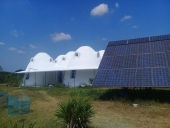posted 6 years ago
Thank you again, John. Great questions. As for barrels and a larger water tank..we have one of those also..and all are being reused in great condition. Barrels vary, but are usually one of two types which are plastic with screw-on lids, or metal with a "food-safe" coating inside. I think the plastic ones are preferable for water collection. Right now we are getting ready to begin plastering the exterior. The average annual rainfall is approximately 960 mm. Our foundation ought to be super for keeping moisture flowing away, as it was dug very deep under the entire space of the house and backfilled and also built up a bit to create flow away. We have sealed the base levels of earthbags with an "impervious" plastic layer, but do not intend to use one beneath thecflooring, rathering to create a capillary beeak with larger gravel and work up to finer layers, includingbrick dust, whic we also have obtained for use in the plaster. We will also bury some tubing with holes and fill around with medium sized gravel etcetera.
We have procured what is simply labelled "cal hidratada" and "para revoques", for plasters. It says 100%. And this seems to be the only type available here. It is in powder form. Although you can also buy a liquid solution used for lime washes, usually in smaller bags. These bags are 20 and 25 kilos.
We have two grades of river sand, and red brick powder is on its way. The idea is to also finish this with waterglass, which we will be ordering soon. We have one very furry dog and one less so, who have agreed to contribute fur for strengthening fibers. I have yet to consult the baby horse, but I will chat with him today and ply him with carrots.
And how could I forget?¿ Fermented cactus juice.






